Solutions for C2 House Price Prediction(Regularized Liner Model)
1 Introduction
1.1 Competition Description
Ask a home buyer to describe their dream house, and they probably won’t begin with the height of the basement ceiling or the proximity to an east-west railroad. But this playground competition’s dataset proves that much more influences price negotiations than the number of bedrooms or a white-picket fence.
With 79 explanatory variables describing (almost) every aspect of residential homes in Ames, Iowa, this competition challenges you to predict the final price of each home
1.2 Statement
Originator:Alexandru Papiu
Analyzed:Tinky Wu
1.3 Basic Ideas
2 Data Processing
2.1 Import package and load data
import pandas as pd
import numpy as np
import seaborn as sns
import matplotlib
import matplotlib.pyplot as plt
from scipy.stats import skew
from scipy.stats.stats import pearsonr
%matplotlib inline
train = pd.read_csv("../input/train.csv")
test = pd.read_csv("../input/test.csv")
2.2 Data exploration
First, let’s look at the basic data
train.head()

data.info()

2.3 Preprocessing
all_data = pd.concat((train.loc[:,'MSSubClass':'SaleCondition'],
test.loc[:,'MSSubClass':'SaleCondition']))
#Process the dataset together
matplotlib.rcParams['figure.figsize'] = (12.0, 6.0)
#{ rcParams } Set the Image pixel, 'rc' means configuration
prices = pd.DataFrame({"price":train["SalePrice"],
"log(price + 1)":np.log1p(train["SalePrice"])})
prices.hist()

We can see that we have transformed srewed values after the log transform
train["SalePrice"] = np.log1p(train["SalePrice"])
#log transform the target
numeric_feats = all_data.dtypes[all_data.dtypes != "object"].index
#log transform skewed numeric features
#If all the data in the column is not object, the column will be selected
skewed_feats = train[numeric_feats].apply(lambda x: skew(x.dropna())) #compute skewness, just for the training set
skewed_feats = skewed_feats[skewed_feats > 0.75]
#Choose the numeric column that skewness>0.75
skewed_feats = skewed_feats.index
all_data[skewed_feats] = np.log1p(all_data[skewed_feats])
#Transform the chosen columns
2.4 One-Hot Encoding
#fill the missing value and create matrices for sklearn
all_data = pd.get_dummies(all_data)
all_data = all_data.fillna(all_data.mean()) #filling NA's with the mean of the column
X_train = all_data[:train.shape[0]]
X_test = all_data[train.shape[0]:]
y = train.SalePrice
3 Modeling
After the simple transform, now using regularized linear regression models
The author tried both l_1(Lasso) and l_2(Ridge) regularization
He also defined a function that returns the cross-validation rmse to evaluate the model
3.1 Basic Model: Ridge & Lasso
from sklearn.linear_model import Ridge, RidgeCV, ElasticNet, LassoCV, LassoLarsCV
from sklearn.model_selection import cross_val_score
【rmse】:root-mean-square error: Measures the deviation between Observed value and Truth-value
def rmse_cv(model):
rmse= np.sqrt(-cross_val_score(model, X_train, y, scoring="neg_mean_squared_error", cv = 5))
return(rmse)
model_ridge = Ridge()
higher alpha means more restriction on coefficient ‘w’ (May improve the generalization performance and avoid overfit)
alphas = [0.05, 0.1, 0.3, 1, 3, 5, 10, 15, 30, 50, 75] # Adjusting parameters
cv_ridge = [rmse_cv(Ridge(alpha = alpha)).mean() for alpha in alphas]
#Visualization: alphas-rmse
cv_ridge = pd.Series(cv_ridge, index = alphas)
cv_ridge.plot(title = "Validation - Just Do It")
plt.xlabel("alpha")
plt.ylabel("rmse")

Now we check the Root Mean Squared Logarithmic Error(The smaller the better)
cv_ridge.min()

Next we try Lasso
model_lasso = LassoCV(alphas = [1, 0.1, 0.001, 0.0005]).fit(X_train, y)
rmse_cv(model_lasso).mean()

Lasso does feature selection for you - setting coefficients of features it deems unimportant to zero. It performs somewhat better than ridge model.
3.2 Check the model
Check how many features it choose
coef = pd.Series(model_lasso.coef_, index = X_train.columns)
print("Lasso picked " + str(sum(coef != 0)) + " variables and eliminated the other " + str(sum(coef == 0)) + " variables")

Take a look directly at what the most important coefficients are
imp_coef = pd.concat([coef.sort_values().head(10),coef.sort_values().tail(10)])
matplotlib.rcParams['figure.figsize'] = (8.0, 10.0)
imp_coef.plot(kind = "barh")
plt.title("Coefficients in the Lasso Model")

These are actual coefficients ’w‘ in your model
It’s easier to explain the predicted price concluded by the model
Now we check the residuals
matplotlib.rcParams['figure.figsize'] = (6.0, 6.0)
preds = pd.DataFrame({"preds":model_lasso.predict(X_train), "true":y})
preds["residuals"] = preds["true"] - preds["preds"]
preds.plot(x = "preds", y = "residuals",kind = "scatter")

3.3 Add another model: xgboost
import xgboost as xgb
dtrain = xgb.DMatrix(X_train, label = y)
dtest = xgb.DMatrix(X_test)
params = {"max_depth":2, "eta":0.1}
model = xgb.cv(params, dtrain, num_boost_round=500, early_stopping_rounds=100)
model.loc[30:,["test-rmse-mean", "train-rmse-mean"]].plot()#visualize the rmse-mean changing

model_xgb = xgb.XGBRegressor(n_estimators=360, max_depth=2, learning_rate=0.1) #the params were tuned using xgb.cv
model_xgb.fit(X_train, y)
4 Predicting
xgb_preds = np.expm1(model_xgb.predict(X_test))
lasso_preds = np.expm1(model_lasso.predict(X_test))
predictions = pd.DataFrame({"xgb":xgb_preds, "lasso":lasso_preds})
predictions.plot(x = "xgb", y = "lasso", kind = "scatter")

Take a weighted average
preds = 0.75*lasso_preds + 0.25*xgb_preds #Take a weighted average of uncorrelated results
solution = pd.DataFrame({"id":test.Id, "SalePrice":preds})
solution.to_csv("ridge_sol.csv", index = False)
5 Results

If there’s any flow, please point out. Thank you!